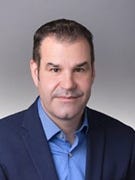D&H Distributing Shares Big Cloud AspirationsD&H Distributing Shares Big Cloud Aspirations
The distributor's new cloud strategy executive outlines the company's vision.
February 27, 2019

D&H Distributing recently announced that it hired IT and channel veteran Jason Bystrak to shape its cloud computing business strategy.
Savvy move. Bystrak is well known in distribution and among channel partners, having spent 22 years at competitor Ingram Micro. He helped Ingram launch its cloud computing business plan. He joined D&H Distributing after a short stint at Axcient, where he was vice president, worldwide channels and distribution.

D&H Distributing’s Jason Bystrak
Although still early in his tenure with D&H Distributing, Channel Futures spoke to Bystrak to hash out his role, strategy and objectives for the year.
Channel Futures: Let’s start with you outlining your job responsibilities at D&H.
Jason Bystrak: I was brought in to lead the cloud business unit, which is a newly formed business unit here at D&H. Historically, the company has had a great Microsoft partnership and they sprinkled in a few other cloud vendors, but the team has a vision to take this to the next level.
They want to dedicate the right resources to [the cloud business]. That’s why I’m here. We’re going to build that out with a more formalized team of sales experts, vendor management folks that are building the right business plans and executing them, a strong marketing team — and then have the operational resources.
CF: Why the move by D&H to take its cloud business to the next level? And, what does that next level look like?
JB: We want to look at selling “X” as a service (XaaS), not just cloud services. D&H already had the great foundation around a device-as-a-service (DaaS) program. We want to put together a great XaaS model, where our partners are going to be able to come in and purchase a device on a monthly subscription model and the proper cloud services to add value to that and add their own services.
We also have a great financing and operational program that allows us to do that because that’s what the end customer is asking for — so we’re meeting a growth opportunity for that.
The other area that we want to focus on is, there [are] still an awful lot of resellers and VARs that have not started the transformation to recurring revenue. So we’re also going to be investing in programs and resources to help [partners] build out a proper managed services model. From there, we’ll add on the proper cloud solutions – SaaS solutions and eventually infrastructure as a service [IaaS] solutions – down the road.
CF: After a brief step away from distribution, you’re back.
JB: I had a great time at Axcient; we did some good work, but this D&H opportunity to lead a larger team and have the support from the executives to build it out was exciting.
Distribution is really the epicenter of everything. When you think about it, you’re working between multiple types of partners, numerous types of vendors and solutions, and because of the size and scale of the business, there’s an awful lot of resources at your disposal to put together interesting programs. It’s exciting and fun to be in the middle of everything.
CF: Having built and executed Ingram Micro’s cloud strategy, what did you learn that lends itself to what you’re doing now?
JB: If I were to summarize the learning there – and it’s definitely relevant here – you learn how to build an organic services-based business, meaning that, and I joke with the cloud team, the phone rings twice a day and once it’s the wrong number saying, “Help me with cloud.” It’s people calling in looking for different solutions, and what we’re doing is offering a cloud-based or an as-a-service-based solution because that’s what the end users are looking for. It’s a lot more about …
… education and partner transformation into that model.
So that’s what I learned — how to build that organic model and help partners make changes to their business.
Secondly, I think operationally, there was a lot of learning about what partners need to efficiently run their business. One of the things we’re focused on is the “3Ps.” The first is people — we’re going to be investing in subject matter experts around cloud. There are already a lot of good people here now, but we’re going to scale it out further, carrying out that training and messaging to the rest of the D&H team so they’re able to help customers with their transformation.
The second area we’ll focus on is process, which starts with cloud platform, so we can on-board the right solutions, create the right packages and have a back-end engine for partners to use to run their businesses.
The last big area is partnerships. You’ll see us get more involved in the MSP ecosystem and recruit new types of partners and add new vendor solutions into our portfolio. What we’re building is cloud clusters, pre-integrated solution bundles to help partners understand how to sell the entire solution.
For example, you think about productivity, like Office 365, you’re going to want to wrap around an endpoint-security solution, a voice solution, an operations solution — so we’re going to make sure that we’ve got a nice portfolio of wraparound services.
CF: How big a nut to crack is educating partners about the MSP model?
JB: We no longer have to grab a partner, shake them and say, “You need to do this.” They need help and advice on how to do it, programs to help them do it, trainings, so that’s where we will come into play — to help partners do that.
We’re very focused on the SMB market and the SMB partners who serve that market. I think there’s a very significant percentage of the partners that we work with every day that are just dipping their toes into that [recurring revenue]. So, not too many have completely figured it out, while there’s a number of partners who are selling a foundational service, like Office 365, but most have not started to wrap around additional solutions, where the money is, and the value is.
CF: What do you hope you’ll be sharing with me about your progress one year from now?
JB: The ultimate goal is very metric-driven, so we’re going to lay out our goals, such as how many partners we have, how frequently are they transacting, how many cloud clusters have we built out. [We’ll] focus on our sales and go-to-market motion, getting partners on board with that foundation solution and wrap around the complementary offers in the cluster. We’ll measure ourselves by how well we’ve done that.
About the Author
You May Also Like


